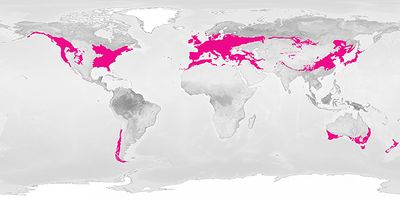Ecology/Deciduous Forests
Deciduous forests are one of the biomes discussed in the Ecology event, particularly in the 2017 season. Deciduous forests contain deciduous plants (mainly trees) which drop their leaves for part of the year in a process called abcission. Abscission occurs because trees do not have enough water or resources to support their leaves in the winter. Specifically, trees have less energy because the weak winter sunlight leads to less photosynthesis. This lack of energy forces trees to eliminate some functions, such as leaves. The deciduous forest is the opposite of the coniferous forest, whose plants keep their leaves year long.
Types of Deciduous Forests
There are two main types of deciduous forests: temperate and tropical/subtropical. Temperate deciduous forests are by far the most common, and are what many think of when they hear the term deciduous forest. Tropical and subtropical deciduous forests are located at tropical and subtropical latitudes, and they experience long dry seasons which impact the organisms in the forest.
Location
Deciduous forests can be found in the eastern half of North America, and the middle of Europe. There are many deciduous forests in Asia. Some of the major areas that they are in are southwest Russia, Japan, and eastern China. South America has two big areas of deciduous forests in southern Chile and Middle East coast of Paraguay. There are deciduous forests located in New Zealand, and southeastern Australia also.
Climate
The temperate deciduous forest is a biome that is always changing. It has four distinct seasons: winter, spring, summer and fall. Winters are cold and summers are warm. Temperatures vary from -30° C to 30° C. The average temperature of the forest is about 50 degrees Fahrenheit. Precipitation (75-150 cm) is distributed evenly throughout the year. The average rainfall here in the forest is 30 to 60 inches a year.
Ecologic Importance
The temperate forest is extremely important ecologically. They help to reduce erosion from the trees stabilizing the soil. The Deciduous Forests provide habitat and food for many animals including migratory birds from the Tundra. The forests aid in maintaining biodiversity, regulating local climate, and producing oxygen. This helps to stabilize weather patterns as well as diminish the effects of greenhouse gas release into the atmosphere. The trees regulate watershed volume to reduce water, while the no one serves as a large water and air filter. As a result, the forest indirectly regulates stream flow and temperature. It aids in nutrient cycling and soil formation and creates a healthier soil for the plants that live in it.



